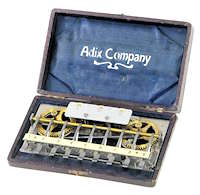 "Adix" single-column adding machine, S/N 4824
"Adix" single-column adding machine, S/N 4824
3-dial decimal, addition only
Nine-key setting mechanism
Dimensions (in case): 155 x 95 x 28mm
Weight (in case): 290g
Manufactured: Adix Company, Germany, 1903-

There are many types of simple adding machines based on rotary discs and dials, and mainly intended for personal or light-duty applications.
Early machines (from the 1850s to the early 1900s) were often designed for adding only a single column at a time - first the units column, then the tens, and so on, in the same way that addition is done manually. These machines were often based on a large flat disc with 100 numbered teeth, with a simple carry mechanism into the hundreds place.
As carry mechanisms improved, multi-column machines were built with rows of smaller 10-tooth dials mounted flat on a long ruler-like base. These "multi-axis" machines were quite popular during the 1920s and 30s.
The most common design of small adders involves a series of metal or plastic discs, numbered around their edges, and mounted on a single horizontal axis to form a "register" or "accumulator". In simple machines the discs are often rotated directly by finger pressure, or with a hand-held stylus. In more complex versions the register dials are rotated indirectly through various sorts of setting and actuating mechanisms.
Most of the simple machines rotate only in one direction, and most are limited to addition only. Subtraction (when offered) is usually done by the addition of complements, although some machines have reversible registers and some are fully bi-directional. There is a wondrous variety in the arrangement of the discs, dials, and tens-carry mechanisms.
Most of these small adding machines were fairly short-lived. Some (such as the Rambler/Alexe) were sold as novelties, while others (such as the far more capable Resulta) continued in production for almost 40 years. Low-cost machines such as the Solo and Swift are still quite common in Australia, as they were sold in quantity during the mid-1960s to assist in the change-over to decimal currency.
The machines on this page show something of the variety and the progress in the construction, operation, and internal mechanisms of typical small adding machines. Click on the photos or links for larger illustrations.
 "Adix" single-column adding machine, S/N 4824
"Adix" single-column adding machine, S/N 4824
3-dial decimal, addition only
Nine-key setting mechanism
Dimensions (in case): 155 x 95 x 28mm
Weight (in case): 290g
Manufactured: Adix Company, Germany, 1903-
The Adix from 1903 is a single-column key-driven adding machine with a 3-digit result register. Martin attributes the design to the German clockmakers Pallweber & Bordt, and this horological heritage is clearly evident.
The mechanism is constructed of steel and brass, with a brushed aluminium escutcheon around the numeral wheels. The mechanism sits fully exposed in a lined wooden case, which can easily be carried in a coat pocket. A sliding rack at the front of the machine carries a series of graduated ramps, such that pressing a key will move the rack a corresponding distance to the right. This movement is communicated via a diagonal rod to an arm which rests on the right-hand gear. As the key is pressed the arm rotates anti-clockwise, but the gear is held by a backstop pawl at the top. As the key is released a spring pulls the rack back to its home position, advancing the gear by the required amount. The gear then drives a 3-dial register with a simple odometer-style tens-carry mechanism.
To clear the register, the 1 key is held down to raise a stop into the path of the second dial. The right-hand gear is then spun clockwise by hand until the first two dials stop at 99. When the 1 key is released the two dials advance to 00, and the hundreds advance by 1. The large left-hand gear is then turned anti-clockwise by hand to clear the hundreds dial via a slipping clutch.
Martin says that the Adix was "long discontinued" by 1920, but
the principle lived on is several small machines which re-appeared
at various times until until the 1950s.
Adix mechanism (29kb)
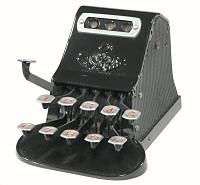 "Adder" single-column adding machine, S/N 7145
"Adder" single-column adding machine, S/N 7145
3-dial decimal, addition only
Ten-key setting mechanism
Dimensions: body 90W x 120D x 115H, overall 120 x 180 x 115mm
Weight: 1.71kg
Manufactured: London, England, early 1900s.
The "Adder" is a single-column desktop adding machine with a three-digit register and a ten-key setting mechanism. The three dials are mounted side by side behind the window at the top of the machine. The setting keys are numbered from 1 to 10 and operate on the right-hand (units) dial only. An automatic tens-carry mechanism advances the tens and hundreds dials as required. The clearing lever at the left-hand side returns the three dials to zero.
The machine has a one-piece cast-iron casing with sheet-metal top and bottom covers. The trade mark embossed into the top cover includes a large snake. The mechanism was designed by Arthur Postans of South Kensington, and is described in his British Patent 24868 of 1902 (also in US Patent 786839, filed in 1903). Martin (p200) suggests that the machine did not enter production until 1908, and was discontinued by the 1920s.
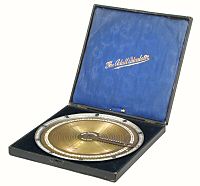 The Adall Calculator
The Adall Calculator
Single column, addition only
Direct operation by stylus
Dimensions: 195mm diameter x 6mm thick, case 210 x 210 x 28mm
Weight: calculator 190g, with case 440g
Manufactured: Adall Company, Birmingham, England, 1910-1920s
The Adall Calculator from 1910 is a single-column adding machine based on a hundred-tooth disc. The Adall is presented in a fitted and lined wooden case, with a pocket for a small bone operating stylus. Some versions have the name spelt "Adal" rather than "Adall".
The mechanism consists only of two concentric discs. The outer (setting) disc of 0.8mm aluminium forms the base of the machine. A ring on the back is slipped over the middle finger so that the machine can be held flat against the palm of the hand. The outer disc is marked anti-clockwise from 0 to 100, with the tens highlighted. The inner (results) disc is marked from 0 to 100, corresponding to the 100 teeth around its outer edge. A flat cross-bar runs from the centre to the zero position on the outer disc to act as a stop. To add, the stylus is placed in the tooth opposite the desired number on the outer setting disc, and the inner disc is pulled clockwise until the stylus reaches the stop. The result appears in the window in the cross-bar.
To count beyond 100, the inner disc is embossed with a deep spiral groove. A steel ball of 1/8" diameter rolls in the groove, and is restrained by a slot in the cross-bar. As the disc turns, the ball travels inwards, so that the hundreds can be read from the scale on the cross-bar. There is no reset mechanism - the inner disc is simply wound backwards for as many turns as necessary at the end of the calculation.
To use the machine to add a list of items in Sterling currency, the pounds, shillings, and pence columns are added separately. When the pence column has been added, a table supplied with the machine is used to convert the total (eg 172d) to 14/4. The 4d is recorded, and the 14 is used to start the addition of the shillings column. Conversion of shillings to pounds (division by 20) is left to mental arithmetic.
The Adall Calculator is described in US Patent 920840, filed by
Dreyfus and Levy of Birmingham in 1908. The same principle can be
found in much earlier machines - for example, a wooden 100-tooth adder
with a spiral carry mechanism is described in US Patent 49168, issued
to T.T.Strode in 1865. It is not known whether the Strode device was
ever manufactured.
Adall scale detail (33kb)
Adall conversion table extract (29kb)
 BriCal Adding Machine, S/N B-832
BriCal Adding Machine, S/N B-832
Six column, Sterling currency, addition only
Direct operation by stylus
Dimensions: 190mm diameter x 11mm thick, case 225 x 225 x 27mm
Weight: calculator 920g, with case 1300g
Manufactured: British Calculators Ltd, London, 1905-1920s
The "BriCal Adding Machine" is a multi-column concentric-disc machine which was made in England from about 1905. The machine has a heavy brass base and a blackened brass cover. The numerals and Bri-Cal logo appear to have been engraved by hand. The machine is packaged in a lined and fitted presentation case with an embroidered name badge and holders for two operating styluses.
In operation, the six concentric discs are drawn clockwise with the stylus to add pounds, shillings, and pence. The outermost setting disc is marked in pence and ha'pennies to 11-1/2, the next in shillings to 19, and the four inner discs in pounds (0 to 9). The machine has a fully-automatic carry mechanism with over-run protection. The result appears in the six small windows on the right-hand side. The innermost window advances to 29 (thousand) pounds, rather than over-flowing at 10. There is no provision for subtraction.
To clear the machine, the stylus is inserted to the left of the red mark on each disc, commencing at the outside, and drawn around to the stop.
The BriCal machines were also made in versions for
decimal currency.
BriCal S/N B-832 (Sterling) front view (33kb)
BriCal S/N E-850 (decimal) front view (29kb)
Internal detail (38kb)
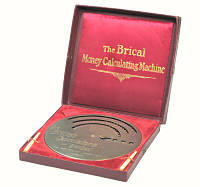 BriCal Money Calculating Machine, S/N 30320
BriCal Money Calculating Machine, S/N 30320
3-4 column, Sterling currency, addition only
Direct operation by stylus
Dimensions: 135mm diameter x 10mm thick, case 160 x 160 x 25mm
Weight: calculator 455g, with case 625g
Manufactured: British Calculators Ltd, London, 1905-1920s
The "BriCal Money Calculating Machine" is a smaller 3-4 column machine which adds Sterling currency to £500. It is packaged in a two-piece presentation case with two imitation-ivory operating styluses.
The machine has three concentric discs which are drawn clockwise
with the stylus to add pounds, shillings, and pence. The pounds disc
is marked to £20, but the window increments to £50 before
carrying. The innermost window advances by 50s to £450. and
needs to be added (mentally) to the pounds window to give the final
result. The £50 window is cleared by pressing and turning the
small knob to its left.
BriCal 30320 front view (31kb)
Scale detail (28kb)
 Calculator Corp 7-dial adder
Calculator Corp 7-dial adder
Decimal, addition only
Direct operation by stylus
Dimensions: 265 x 55 x 6mm
Weight: 290g
Manufactured: Calculator Corp, Grand Rapids, Michigan, 1908-
This machine consists of a flat steel baseplate with seven slotted brass discs mounted side by side on 35mm centres. The discs are visible through 25mm cut-outs in the cover plate. The detail view shows the setting numbers around the outside of the cut-outs. The result numbers are stamped into the baseplate, and are visible through the single deep slot in each disc.
To add, a stylus is inserted at the required setting number, and
the disc is drawn clockwise to the stop at zero. Tens-carries are
automatic, with the result appearing through the slots in the discs.
There is no provision for subtraction. To reset the machine, the stylus
is inserted at the enlarged slot showing the result number, and the
disc is turned backwards to the stop.
Scale detail (28kb)
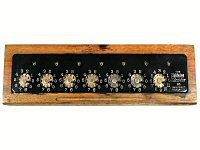 Lightning Calculator 7-dial adder
Lightning Calculator 7-dial adder
Sterling currency, addition only
Direct operation by stylus
Dimensions: calculator 305 x 65 x 6mm, with base 335 x 85 x 60mm
Weight: calculator 250g, with base 780g
Manufactured: Lightning Calculator Co, Grand Rapids, Michigan, 1908-
The Lightning Calculator is an improved version of the machine above, from the same factory in Grand Rapids. The setting dials are wider apart, with larger and clearer numbers. The result is read in a straight line through the peep-holes along the top of the machine, rather than at varying angles through the holes in the setting discs. The slot to use for clearing is identified by two red lines on the disc. An improved overthrow mechanism is described in US Patent 1574249, filed by Robert Hook of Grand Rapids in 1921.
The machine illustrated is built for Sterling currency, without
Farthings. The ten-shillings setting dial is marked to 9, allowing
one to enter (eg) 57/6 in the common format and have it appear
as £2/17/6. The machine is mounted at a 30° angle on a
triangular wooden base.
Scale detail (30kb)
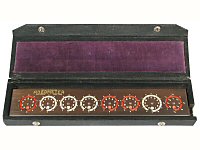 Addometer 8-dial adder, S/N 032062
Addometer 8-dial adder, S/N 032062
Addition, subtraction, and clearing
Direct operation by stylus
Dimensions: calculator 290 x 60 x 15mm, case 310 x 80 x 30mm
Weight: calculator 430g, with case 620g
Manufactured: Reliable Typewriter and adding Machine Corp, Chicago, 1930s
The Addometer from the 1930s is a much more refined and capable machine. The detail view shows two sets of numbers around the setting discs. The larger numbers are used with clockwise movement for addition, and the smaller (complements) are used with backwards movement for subtraction. The carry mechanism operates in both directions, with the result appearing in the row of windows at the bottom of the setting discs. The machine is cleared in one movement by pulling the slide at the lower right outwards for about 50mm. The metal operating stylus is stored in the bottom right-hand corner of the machine, and is ejected by operating the clearing slide. The operating instructions are summarised in two lines on the front edge. The back edge is marked with an eleven-inch ruler.
The machine illustrated has six decimal dials colour-coded for
currency, with two dials at the right graduated for inches and
eighths. The Addometer mechanism is described in US Patent 1764915,
filed by Anders Vethe of Chicago in 1928.
Scale detail (29kb)
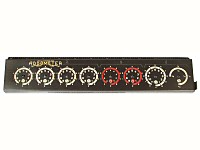 Addometer 8-dial adder, S/N 016813
Addometer 8-dial adder, S/N 016813
Sterling currency, addition, subtraction, and clearing
Direct operation by stylus
Dimensions: 290 x 60 x 15mm
Weight: 430g
Manufactured: Reliable Typewriter and adding Machine Corp, Chicago, 1930s
An 8-dial Addometer for Sterling currency. The machine illustrated has four decimal dials in white for pounds, ten-shillings and shillings in red, and pence and farthings in white at the right-hand side. The ten-shillings setting dial is marked to 9 in both directions, allowing both addition and subtraction in the common format (eg 37/6).
The Reliable Typewriter name has been milled out of the front edge
of this machine and replaced with "Taylor's 74 Chancery Lane London".
Scale detail (28kb)
Addometer packing box (front and rear, 30kb)
 Ricoh Alexe 5-dial adder, decimal
Ricoh Alexe 5-dial adder, decimal
Addition, subtraction, and clearing
Direct operation by push-buttons
Dimensions: body 140 x 45 x 25mm, with case 170 x 65 x 30mm
Weight: calculator 90g, with case 130g
Manufactured: Ricoh, Japan, 1960s
The Ricoh Alexe is a relatively modern 5-dial adder which is operated by push-buttons rather than by stylus. Each press of a button advances the corresponding dial by one unit, with automatic carries. Two spring-loaded control slides extend from the right-hand side of the case. The upper selects addition or subtraction, while the lower is pulled repeatedly to return the dials to zero.
The Alexe mechanism is described in US Patent 3312395, filed by
Masaharu Nara of Tokyo in 1965. The machine was also sold under the
name "Rambler", with only minor changes to the slide handles and the
face plate. The machines were supplied in a 2-part case with a
transparent plastic cover. A sticker on the Rambler box proclaims
"Unique novelty".
Rambler adder in case (22kb)
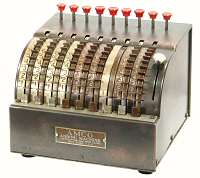 AMCO adding machine, S/N 90204
AMCO adding machine, S/N 90204
9 columns, Sterling currency, with subtraction scales
Direct operation by toothed discs
Dimensions: 170W x 160D x 145H
Weight: 3.53kg
Manufactured: Accounting Machine Company, New York, 1917-
The AMCO is a single-axis multi-column adding machine with a setting mechanism operated directly by finger pressure on rotary metal discs. Each setting disc has a series of projecting tabs numbered from 1 to 9, with complements from 8 to 0 for subtraction. The finger is placed on the required tab and drawn down to the shelf at the front, advancing the register at the top of the machine by the corresponding number of places. The short vertical tabs in front of the discs operate a locking mechanism to prevent overthrow on reaching the bottom of the stroke. The setting discs drive the register through a ratchet mechanism, and return to their home position when released.
The machine has an automatic spring-assisted carry mechanism, with a register clearing lever at the right-hand side. The red buttons along the top are cut-off levers for use in subtraction. The machine illustrated has nine columns, and is configured for Sterling currency.
The AMCO machine was designed by Fred H Doerr of Grand Rapids,
Michigan, and is described in his US Patent 1398068, filed in 1917. The
machine was built by (or for) the Accounting Machine Company (AMCO)
of New York. In 1922 the rights were sold to the Todd company, and the
machine was renamed as the "Star". US Patent 1560381 from 1923
describes a combined carry handle and locking mechanism that was added
later.
AMCO setting mechanism (from Doerr patent, 30kb)
 Comptator adding machine, S/N 8065
Comptator adding machine, S/N 8065
13 columns, Sterling currency, addition only
Operation by stylus and toothed slides
Dimensions: 60W x 205D x 32H, case 100 x 220 x 45mm
Weight: calculator 750g, with case 960g
Manufactured: Hans Sabielny, Dresden, Germany, 1922-
The Comptator is a multi-column adding machine with a setting mechanism operated by linear slides. The machine has a register of close-spaced dials of about 20mm in diameter behind a window in the lower section. A stylus is inserted in the toothed slides in the upper section and is drawn down to the stop, advancing the register by the corresponding number of places. The slides remain in their final position, so that the value entered can be read back for verification in a straight line above the stop. The slides spring back to their home position when released by the lever on the left-hand side. The lever can be latched down to give an immediate return if checking is not required. The detail view shows the slides after an entry of 12345.
The register has an automatic carry mechanism. To clear the result, the knob on the right is pulled outwards and turned anti-clockwise to the stop, and then returned to its home position. The machine illustrated has 13 columns, and is configured for Sterling currency, with Farthings.
Although the unit above dates from the 1920s, the machine was
actually designed in 1891 by Peter J Landin of Minneapolis (US Patent
482312). According to Martin (p118), the device was manufactured and
sold as the "Rapid Computer Adding Machine" from 1893. The Comptator
name was used for a (slightly) improved version built by Schubert &
Salzer of Chemnitz in Germany from 1909 (Swiss patent 50980).
Production was transferred to Hans Sabielny of Dresden from 1922.
Sabielny was later involved in the manufacture of Facit calculators
in Dusseldorf during the 1950s and 60s.
Comptator in case (28kb)
Setting slide detail (30kb)
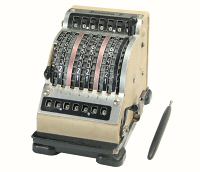 Resulta 7 adding machine, S/N 679-768
Resulta 7 adding machine, S/N 679-768
7 columns, decimal, addition and subtraction
Operation by stylus and toothed discs
Dimensions: 90W x 150D x 110H
Weight: 1.30kg
Manufactured: Paul Brüning, Berlin, 1927-1969
Paul Brüning's machine tool works was established in Berlin in 1911, but did not produce calculators until around 1927. Production was disrupted during the war, but resumed in 1950 and continued until 1969. The machine illustrated is from 1968.
The Resulta is a single-axis multi-column machine with a setting mechanism operated by a stylus and toothed discs. The setting discs operate through a ratchet mechanism similar to the AMCO (above), but remain in position at the end of the stroke so that the value entered can be read from the register at the lower front of the machine. The result appears in the accumulator register at the top. The cross-bar at the front of the machine is pressed down to release the setting discs, or it can be locked down to provide an immediate return.
The machine has a complementary (rocking-type) accumulator, which can be set for addition or subtraction via the lever on the left-hand side. Subtraction is performed directly, without the use of complements. The clearing lever is to the right of the setting discs.
The Resulta has a welded sheet-metal case and an aluminium faceplate, with most of the operating components made from a heavy die-cast alloy. There were many variations - seven or nine columns, with or without subtraction, lever or crank for clearing, and even a version with a printing mechanism.
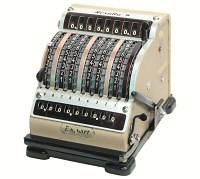 Resulta 9E adding machine, S/N 695-466
Resulta 9E adding machine, S/N 695-466
9 columns, decimal, addition and subtraction
Operation by stylus and toothed discs
Dimensions: 110W x 150D x 110H
Weight: 1.68kg
Manufactured: Paul Brüning, Berlin, 1927-1969
A 9-column "Export model" Resulta from 1966. The only difference between this and the standard model above is in the decimal point and thousands separators on the faceplate.
The Resulta advertised an ability for subtraction below zero, which sometimes requires the machine to perform a "ripple carry" across the entire accumulator. In a machine with an unassisted tens-carry mechanism, the cumulative free play makes it impossible for a one-digit movement to produce a ripple carry over more than about 8 or 9 columns. This machine will carry reliably over 8 places, but will not always succeed with 9, even after cleaning and rebuilding. It may have done better when it was new. (The 13-column Comptator (above) will not carry beyond 7 places, but it has no provision for subtraction).
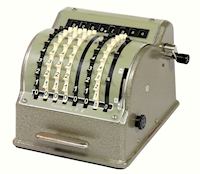 Summira 8£ adding machine
Summira 8£ adding machine
8 columns, Sterling currency, direct subtraction
Direct operation by toothed discs
Dimensions: body 145W x 170D x 130H
Weight: 2.4kg
Manufactured: Summira, West Germany, c.1955-1970
The Summira adder is a simple machine operated directly by finger pressure on toothed discs. It was made in 7, 8, and 9-column versions, some with direct subtraction, some with a printing mechanism, and some sold under a variety of other brand names. The machines were built in West Germany from the mid-1950s until about 1970. The Summira firm still exists, and is currently involved in high-tech metal cutting and manufacturing.
The machine illustrated is an 8-column version for British currency (with farthings). To operate the machine, a finger is placed successively on the tooth opposite each required digit and drawn down to the stop at the front, advancing the register by the corresponding number of places. The discs remain in this position at the end of the stroke, so that the digits entered are displayed for checking in a horizontal line just above the stop. Pressing the bar at the front of the machine resets the discs for the next entry. The bar can be locked down with the knob on the right-hand side to bypass the checking process and allow the discs to return immediately.
This machine has a complementary accumulator for direct subtraction, with an add/subtract selector lever near the front right-hand corner. Only one disc can be operated at a time, as the tens-carry mechanism can not cope with simultaneous entries. (The Resulta above has the same limitation, which is neatly hidden by the use of a single operating stylus). The register is cleared by a single turn of the small crank at the upper right-hand side.
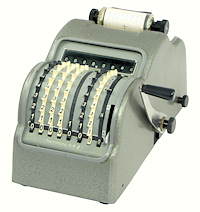 Summira S8£ adding and printing machine
Summira S8£ adding and printing machine
8 columns, Sterling currency, printing, direct subtraction
Direct operation by toothed discs
Dimensions: body 140W x 300D x 160H
Weight: 4.9kg
Manufactured: Summira, West Germany, c.1955-1970
The Summira S8£ is similar to the 8£ above, with the addition of a lever-operated printing mechanism at the rear.
Setting a number on the discs adds it directly into the register and retains the number for checking and printing. Pulling the handle forward then prints the number and resets the discs, ready for the next entry. The connection between the setting discs and the more closely spaced spring-loaded print wheels is made by a series of eight small chains running over a curved guide plate.
This Summira machine has no direct means for clearing the register or for printing a total. To perform these operations, the machine must first be set for subtraction. Then the number in the display window is copied by hand into the setting discs, thus returning the register to zero. Pulling the handle then prints the value on the discs (ie, the previous total), and leaves the register empty.
The cover must be removed (via the thumb-screws at the side) to
change the printer paper or the ribbon.
Summira S8£ internal view.
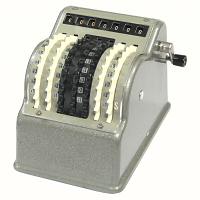 Hoffritz adding machine
Hoffritz adding machine
7 columns, decimal, with subtraction scales
Direct operation by toothed discs
Dimensions: 120W x 170D x 130H
Weight: 1.13kg
Manufactured: Summira, West Germany, 1960s
This "Hoffritz" adder is a variant of the Summira 7-column adding machine, and is essentially the same as the Summira "Chieftan". The mechanism has only a single accumulator, with a small rotary crank for clearing the result. The faceplate is marked with complement scales for use in subtraction, with a large "S" marked at the lower right of the discs to remind the operator to add the final 1.
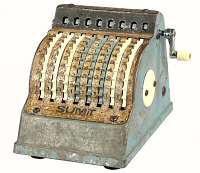 "Sum-it" Adding Machine
"Sum-it" Adding Machine
8 columns, decimal, addition only
Direct operation by toothed discs
Dimensions: 130W x 180D x 140H
Weight: 1.42kg
Manufactured: Pearl Engraving Corp, New York, 1950s
The Sum-it adding machine from the 1950s is a multi-column machine operated directly by finger pressure on toothed discs. The scales on the faceplate are marked for addition only. The result appears in the register at the top of the machine, and is cleared by a full turn of the handle on the right-hand side. There is an automatic (unassisted) tens-carry mechanism. The Sum-it has a die-cast alloy casing, with plastic setting discs and register dials. The example illustrated has been stored in poor conditions.
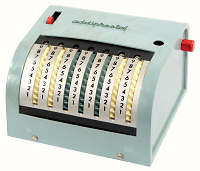 Addipresto adding machine
Addipresto adding machine
7 columns, decimal, addition only
Operation by stylus and toothed discs
Dimensions: 140W x 135D x 90H
Weight: 455g
Manufactured: Brevetti Lanza, Savona, Italy, 1950s
The Addipresto is a stylus-operated toothed-disc machine which uses the discs themselves to display the result, rather than having a separate register mechanism. The setting discs are larger and wider than usual, with 40 setting teeth and the numbers 0 to 9 repeated four times around the circumference. The numbers on the discs are printed to the left of the setting teeth and are hidden behind the setting numbers on the faceplate, except for the digits of the result, which appear in a series of small windows at the top.
The machine has an automatic spring-assisted carry mechanism, which also acts to return the dials to zero when released by the lever at the top left. The operating stylus is stored horizontally in the hole in the right-hand side, but can also be stood vertically in the top hole during use.
The Addipresto is a simple but elegant mechanism, designed by Sergio Lanza of Savona in Italy, and is described in his Italian Patent 554094 of 1956.
 Swift Handy Calculator
Swift Handy Calculator
7 columns, decimal, with subtraction scales
Operation by stylus and toothed discs
Dimensions: 140W x 135D x 90H
Weight: 455g
Manufactured: "Made in Hong Kong No 163", 1960s
The Swift Handy Calculator is a Hong Kong copy of the Italian Addipresto. The copy is actually better made than the original, as it includes two metal reinforcements to strengthen the case and resist the tension of the detent and carry springs. The Swift faceplate includes complement scales for subtraction, but the machines are otherwise identical.
The internal view
shows the carry operating pawls at the rear of the machine. As numbers
are added, a four-lobed snail cam on the side of each dial draws the
pawls backwards and tensions the springs. When the dial passes from
9 to 0, the cam drops and the pawl advances the next dial by one place.
A separate detent pawl holds the dials in place and prevents them
rotating backwards. The clearing lever lifts all the detents and the
carry pawls, allowing the carry springs to push the snail cams and
dials back to zero.
Internal view (29kb)
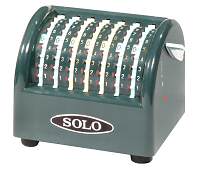 "Solo" Handy Adding Machine
"Solo" Handy Adding Machine
7 columns, decimal, with subtraction scales
Direct operation by toothed discs
Dimensions: 130W x 100D x 125H
Weight: 355g
Manufactured: Solo Calculating Machine Co Ltd, Japan, 1960s-70s
The Japanese Solo adding machine is another design which has no separate register. The machine is operated directly by finger pressure on the toothed discs, with the result appearing in a row of windows in the centre of the setting dials (at the number 5 position). The dials are returned to zero by the lever on the right-hand side.
For subtraction, the setting scales are marked in red with tens-complements (ie, 9 to 1, instead of the usual 8 to 0) and the dials are rotated backwards. The unassisted tens-carry mechanism operates in both directions.
The all-plastic Solo machines are quite well made, but are not intended
to be taken apart. The cover is glued to the base of the machine, and can not
be removed without damage. The Solo machines are usually green, but later
versions were also available in red. Only the top cover was red - the base
and box were still green, and the instruction sheet still refers to red
numbers for subtraction.
Solo with original carton.
Solo in red.
Solo instruction sheet.
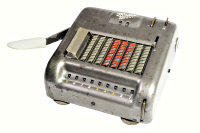 Thales KA Adding Machine, S/N 14917
Thales KA Adding Machine, S/N 14917
8/9 columns, decimal, with subtraction
Keyboard setting, lever actuation
Dimensions: Body 170W x 190D x 90H, overall width 205mm.
Weight: 2.66kg
Manufactured: Thales, Rastatt, Germany, 1952-1963
Emil Schubert's "Thales" factory in Rastatt, Germany is best known for the Thales and Schubert pinwheel calculators, but also produced a line of commercial add-list machines from 1924. This Thales "KA" ("Klein Addier" or "Small Adder") was introduced in 1952 as a (relatively) low-cost machine for light-duty office applications.
The KA mechanism sits somewhere between the simple machines and the full commercial machines in complexity. The keys on the keyboard are hinged on the left, and have a pin extending below. Pressing any key in a column automatically presses all the lower keys, and tilts the pins into line with star wheels on the register dials. When the handle is pressed down the entire register is lifted to engage with the pins and is drawn back to the rear of machine, thus advancing the dials by the corresponding number of places. The tens carries operate on the return stroke. The keyboard is cleared automatically, or manually by pressing the bar at its left.
The machine has a +/- control for direct subtraction without using complements, a Repeat control for multiplication, and a separate 2-digit register at the rear which counts the number of additions. Two thumbwheels are provided for clearing the registers. The reversible operating handle can be fitted to either side of the machine.
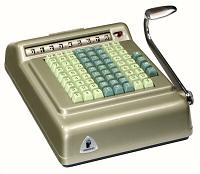 Brunsviga Adding Machine, Model 94T, S/N 22-06061
Brunsviga Adding Machine, Model 94T, S/N 22-06061
8/9 columns, decimal, with subtraction
Keyboard setting, lever actuation
Dimensions: 185W x 270D x 80H (excluding handle)
Weight: 3.66 kg
Manufactured: Brunswick, Germany, 1950-60s
The Brunsviga Model 94T is a basic adding and subtracting machine for decimal currency in an attractive die-cast housing. A version for Sterling currency is illustrated on the Brunsviga page.
The mechanism is based on reciprocating racks, driven by a downwards pressure on the operating handle on the right-hand side. There are only four control buttons - subtract, repeat, keyboard clear, and register clear. The machine is well constructed and easy to use, although rather noisy in operation.
The double-width numeral wheels in the accumulator register have the numbers and their complements marked side-by-side, with a sliding shutter to select the appropriate set. If the total in the register goes negative and displays leading 9s, the operator can slide the shutter to the left (via the small red lever at the top right) to display the true value on the complement digits.
For lever-actuated adding machines with printing mechanisms please see the Printing Calculators page.
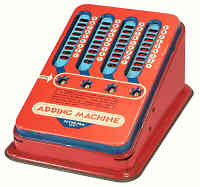 Peter Pan Adding Machine
Peter Pan Adding Machine
4 columns, decimal, addition only
Direct operation by linear slides
Dimensions: 160W x 230D x 110H
Weight: 590g
Manufactured: Made in England, 1950s
The designer of this machine described it as a simple and low-cost adding machine that would also be useful "in the entertaining instruction of children".
The machine is built in the typical "tin toy" style, with light metal pressings held together by folded tabs. Across the centre there is a four-dial accumulator register with an unassisted tens-carry mechanism. The setting slides in the upper section are in the form of small ladders. A fingertip is inserted at the appropriate rung, and the slide is drawn downwards to advance the register by the corresponding number of places. The slide returns immediately when released. The mechanism operates smoothly, although the spring-and-tinplate construction makes it rather noisy. There is no clearing mechanism - the instructions printed on the faceplate advise to start at the right and add whatever is necessary to bring each dial to zero (a good educational exercise in itself).
The mechanism was designed by Linus J Ritz of Pittsburgh, and is described in his US Patent 2243884. The patent was filed in 1939 and assigned to the Wolverine Supply and Manufacturing Company of Pittsburgh. The machine illustrated was made in England, most probably during the 1950s.
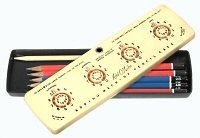 Add-O-Matic Pencil Case
Add-O-Matic Pencil Case
4 columns, decimal, addition and subtraction
Direct operation by rotary dials
Dimensions: 200W x 60D x 20H
Weight: 90g
Manufactured: unknown
This Add-O-Matic is a combined "school calculator" and pencil case, probably from the 1950s.
The upper section contains a bi-directional 4-dial adder and
subtractor of all-plastic construction. The general arangement and the
brief operating instructions are similar to the "Addometer" (above),
but there is no clearing mechanism. The tray in the lower section
holds six pencils and the plastic operating stylus.
Scale detail (28kb)